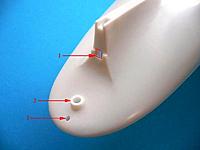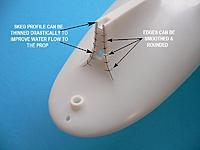Comments (0)
Add Comment
-
 Views: 259
Views: 259
-
 Views: 279
Views: 279
Changes: 1.) Square-shaped prop hole (original is solid) 2.) Flanged rudder hole (original is smooth) 3.) Screw hole for mounting the deck (original nonexistent) -
 Views: 279
Views: 279
1.) Clearance notch for rear deck screw (original is solid) 2.) Rear deck screw flange (original nonexistent) 3.) Notch for rudder tiller clearance (solid on original) 4.) Front deck screw hole (solid on original) -
 Views: 301
Views: 301
This highlight in red represents the last major change to the kit plastic. Clockwise from middle left: button for securing tiller to rudder post, bracket/boss that retains the bow deck screw, prop shaft support bracket, rudder tiller, bracket for on/off
-
 Views: 272
Views: 272
One of many early box art renditions for the Pyro kit. -
 Views: 280
Views: 280
Typical Lindberg box art with retouched photo. Current box art (like this) has different views of the tug on the reverse side. -
 Views: 343
Views: 343
No longer in production but a nice 'first RC boat kit' for beginners. Lindberg also did an RC version of their 1/64 PT-109.



